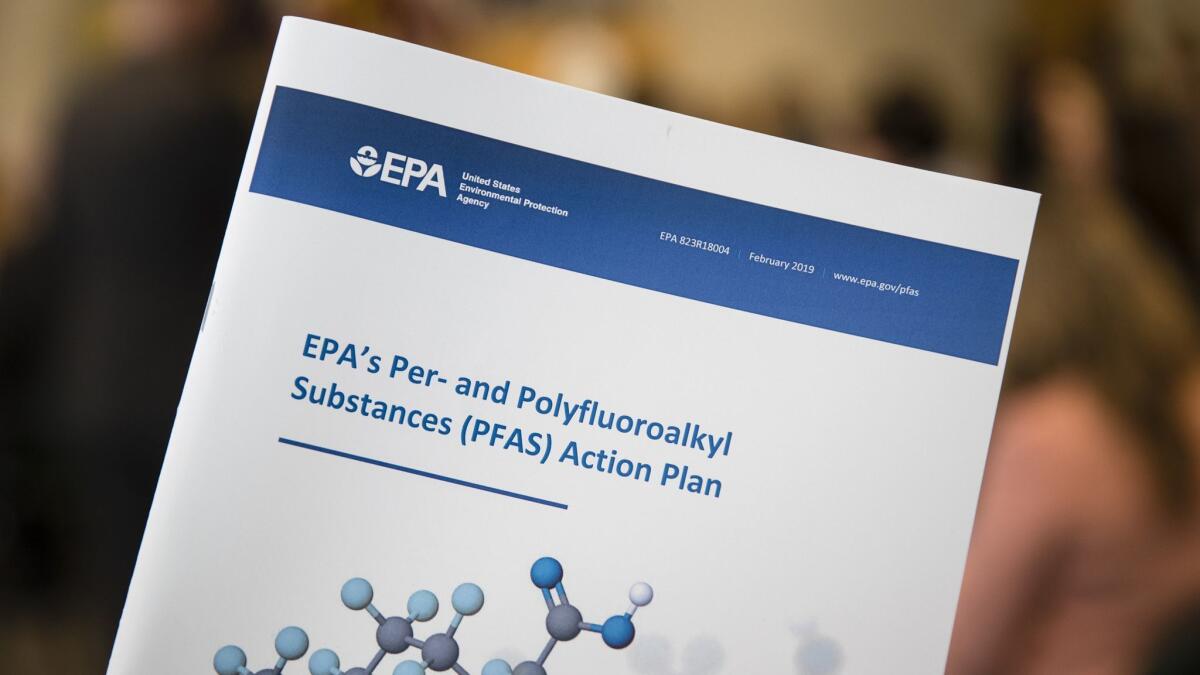Pressured by Congress, EPA moves to limit highly toxic chemicals found in drinking water

- Share via
Reporting from Washington, D.C. — Under pressure from Congress, the Environmental Protection Agency said Thursday it would move toward setting safety limits for a class of highly toxic chemicals contaminating drinking water around the country. Environmentalists, congressional Democrats and state officials countered that the agency wasn’t moving fast enough.
Acting EPA Administrator Andrew Wheeler released an “action plan” for dealing with the long-lasting substances, which have been linked to health threats ranging from cancer to decreased fertility. The perfluoroalkyl and polyfluoroalkyl substances, known collectively as PFAS, have turned up increasingly in public water systems and private wells.
Wheeler said the agency’s plan would help communities monitor, detect and address PFAS pollution.
But environmentalists and some members of Congress said the strategy wasn’t aggressive enough on dealing with the chemicals, which are found in firefighting foam, nonstick pots and pans, water-repellent clothing and many other household and personal items.
“This is a non-action plan, designed to delay effective regulation of these dangerous chemicals in our drinking water,” said Wenonah Hauter, executive director of Food & Water Watch.
Former EPA chief Scott Pruitt described PFAS contamination as a “national priority” and pledged swift action last May. Wheeler has served as the EPA’s acting head since Pruitt’s resignation in July amid ethics scandals, and the agency’s handling of PFAS contamination was raised as an issue in Wheeler’s confirmation hearings.
Scientific studies have found “associations” between the chemicals and cancer, thyroid disease, ulcerative colitis and other health issues.
Sen. Tom Carper of Delaware, the top Democrat on the Environment and Public Works Committee, said the EPA plan did not include a commitment to set safety limits for the chemicals in drinking water and prolonged the evaluation for at least another year.
“It has taken the EPA nearly a year to just kick the can even further down the road,” Carper said. “While EPA acts with the utmost urgency to repeal regulations, the agency ambles with complacency when it comes to taking real steps to protect the water we drink and the air we breathe.”
The EPA strategy focuses largely on two of the oldest and most common PFAS chemicals, both of which have been phased out by manufacturers but remain widespread in the environment. By the end of this year, the EPA will “propose a regulatory determination” for those chemicals, known as PFOS and PFOA, the next step toward establishing limits under the Safe Drinking Water Act, Wheeler said.
The EPA also is moving toward listing PFOA and PFOS as hazardous substances, which could make them eligible for cleanup under the Superfund program, and will issue interim groundwater cleanup recommendations for contaminated sites, Wheeler said. The agency will propose adding PFAS chemicals to a drinking water monitoring program and develop new methods for detecting them in water, soil and groundwater.
Thousands of distinct PFAS chemicals, which resist heat and repel grease, water and oil, have been in production since the 1940s. They’ve been labeled “forever chemicals” because they break down slowly, if at all. Testing of water systems around the nation has turned up varying levels of the compounds.
The EPA has established a nonbinding “advisory level” of 70 parts per trillion for the two older versions, PFOA and PFOS, which the federal Agency for Toxic Substances and Disease Registry has described as too weak. Some states have imposed tougher limits.
More to Read
Sign up for Essential California
The most important California stories and recommendations in your inbox every morning.
You may occasionally receive promotional content from the Los Angeles Times.










